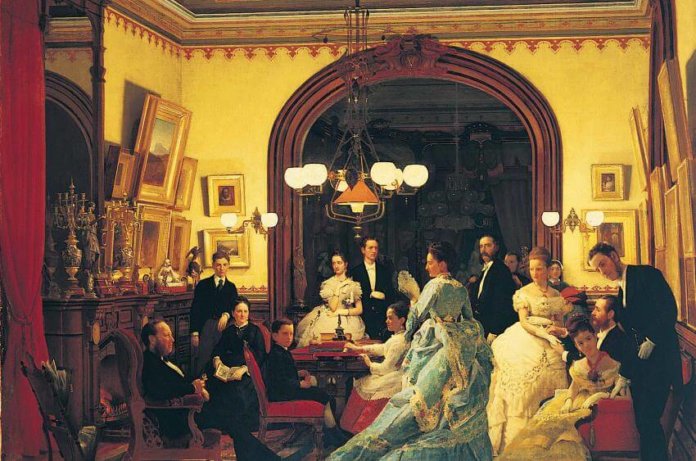
The Vanderbilt family has earned their place as one of the great financial dynasties in American history. With a fortune rooted in the birth of the country’s Gilded Age, the family name conjures up thoughts of lavish lifestyles and shrewd business success. At its peak, the family had more money than what was held in the U.S. Treasury. And yet, for all that the Vanderbilts have accomplished, the true Vanderbilt fortune has been lost. How this happened is a complex tale spanning several generations.
Early Success
The tale of the Vanderbilts in business begins with Cornelius Vanderbilt, a descendant of Dutch settlers who was born to humble beginnings on Staten Island, New York. While his father was a farmer, the elder Vanderbilt also ferried produce and merchandise between Staten Island and Manhattan aboard a two-masted sailing vessel called a periauger. Cornelius would work with his father on the boat as a boy, then aboard his own periauger as a teen, before getting his own small fleet of boats and learning about ship design.
After a brief stint as a ferry captain, Vanderbilt would go on to his first major business success in the 1820s, building steamships and operating ferry lines across the New York region. His clever and aggressive attitude earned him the nickname “Commodore” as well as a fair share of enemies. The peak of his shipping success was during the California Gold Rush, where he created a steamship service that took prospectors from New York to California through Nicaragua. Far faster than the alternative routes, he would earn more than $1 million (about $26 million in today’s money) from this route alone.
The Railroads
However, it was the famed railroad business that the Vanderbilt name came to be forever associated with. Cornelius’s foray into railroads was perfectly timed, as railroads were just beginning to grow into the logistics network that we know them as today. Obtaining control over several railroads between Chicago and New York, he would go on to create a large interregional railroad system.
This development marked a huge change from the smaller, fragmented railroads of the day, each with their own procedures and timetables. The result would be New York Central, a multi-state system with increased efficiency, travel times, and above all, lower costs. These innovations would not only make the Vanderbilts extremely wealthy but would change the landscape of American transportation.
Later in life, unlike many of the other millionaires of the day like Andrew Carnegie or John D. Rockefeller, Cornelius Vanderbilt did not embrace philanthropy to a large degree. Instead, he would leave the bulk of his $100 million fortune to his son William Henry “Billy” Vanderbilt. It is said by some that Cornelius had serious doubts whether or not his children could maintain what he created, and told Billy at one point, “Any fool can make a fortune; it takes a man of brains to hold onto it.”
The Loss of The Vanderbilt Fortune
To Billy’s credit, upon inheriting the fortune as well as the family’s 87% stake in New York Central, he worked hard to expand the business, reportedly doubling the family’s fortune. Upon his death, Billy would go against his father advice of leaving the bulk of the fortune to one person, splitting it between his two sons, Cornelius Vanderbilt II and William Kissam Vanderbilt.
This third generation would mark the beginning of the decline of the Vanderbilt fortune. What went wrong? To put things simply, the Vanderbilts became wealth spenders than wealth creators. Cornelius Vanderbilt II would manage the business until his death, at which point William Kissam took over briefly before retiring to his yachts and horses.
William was once quoted as saying, “Inherited wealth is a real handicap to happiness… It has left me with nothing to hope for, with nothing definite to seek or strive for.” At the same time, the lavish estates and lifestyles typical of the Gilded Age were beginning to eat into the family coffers. Some of these extravagances included art collections, 10 5th Avenue mansions in New York City, and extensive philanthropy.
While this was going on, the business landscape of the railroad industry was changing. By the end of World War II, barges, trucks, and airplanes were cutting into the railroad market. The family would also sell some of the shares in New York Central, creating more room for competitors, and even allowing the competing Chesapeake and Ohio Railway to became a major shareholder. After a disastrous merger in 1968, New York Central would file for bankruptcy in 1970.
The Vanderbilt Legacy
As a financial powerhouse, the Vanderbilt fortune is no more today. In the latest Forbes profile of America’s richest families, the Vanderbilt family is nowhere to be seen. Their lavish New York City mansions have been torn down as well. However, there are still remnants of their great impression on America. Perhaps one of the major ones is Vanderbilt University, one of the few philanthropical endeavors of Cornelius Vanderbilt before his death. The school’s sports teams call themselves the Commodores in his honor.
Despite the loss of fortune, one remaining legacy of the Vanderbilt family is its family members. Descendant Gloria Vanderbilt boasts a net worth of $200 million due to her careers in fashion and art rather than a grand inheritance. Equally well known is her son, CNN news anchor Anderson Cooper, who has forged a great career for himself as well. When asked about his rich ancestors during a Howard Stern interview in 2014, Cooper simply remarked, “My mom’s made clear to me that there’s no trust fund… there’s none of that.”
“Who’s inherited a lot of money that has gone on to do things in their own life?” he continued. “From the time I was growing up, if I felt that there was some pot of gold waiting for me, I don’t know that I would’ve been so motivated.”









